Heterogeneous Multiphase Microstructure Formation through Partial Recrystallization of a Warm-Deformed Medium Mn Steel during High-Temperature Partitioning
Abstract
:1. Introduction
2. Experimental Procedure
3. Results and Discussion
4. Conclusions
- The processing route comprising step quenching to 120 °C, warm deformation at 500 °C, and high-temperature partitioning at 650 °C for 20 min results in the occurrence of various desired microstructural evolutions such as martensite tempering and its partial recrystallization, carbide precipitation, partitioning of elements and austenite reversion.
- The desired multiphase and heterogeneous microstructure of the studied medium Mn steel was composed of several phases including lath-shape tempered martensite, recrystallized ferrite, pearlite, 29% of ultrafine retained austenite (in both lath-type and equiaxed morphologies), some fresh martensite and undissolved carbides.
- A core–shell structure of Mn-lean fresh martensite surrounded by Mn-rich austenite film was detected in the final microstructure of the samples. Despite warm deformation, during the intercritical annealing at 650 °C for 20 min, Mn can diffuse only to a short distance, and in the case of austenite grain size larger than the maximum diffusion distance, an Mn-rich layer around an Mn-lean core was created. The peripheral area of Mn enrichment was stabilized, while the core area tended to transform into fresh martensite during final cooling.
- Employing a warm deformation strain of 40% at 500 °C provided a microstructure exhibiting a wide ferrite grain size range, in addition to a moderate level of recrystallization (i.e., 26%) compared to the microstructural features noticed earlier in the case of samples either deformed at 250 °C or without any deformation. In contrast, the austenite grains displayed a high fraction (i.e., 73%) of dislocation-free grains in a narrow size range. This was attributed to the formation of new dislocation-free austenite grains, though the partial recrystallization of pre-existed austenite cannot be ruled out.
- The calculation of Ms and SFE indicated that the RA in the sample deformed at 500 °C had lower stability in comparison to that in the sample deformed at 250 °C and also, the non-deformed sample. This indicates that by varying the deformation temperature, it is possible to finetune the microstructure stability and heterogeneity in terms of size, distribution, phase fraction, and morphology, known to be beneficial for mechanical properties, particularly tensile ductility.
Author Contributions
Funding
Institutional Review Board Statement
Informed Consent Statement
Conflicts of Interest
References
- De Cooman, B.C.; Lee, S.J.; Shin, S.; Seo, E.J.; Speer, J.G. Combined intercritical annealing and Q&P processing of medium Mn steel. Metall. Mater. Trans. A Phys. Metall. Mater. Sci. 2017, 48, 39–45. [Google Scholar] [CrossRef]
- Lee, Y.K.; Han, J. Current opinion in medium manganese steel. Mater. Sci. Technol. 2015, 31, 843–856. [Google Scholar] [CrossRef]
- Lee, S.; Lee, S.J.; de Cooman, B.C. Austenite stability of ultrafine-grained transformation-induced plasticity steel with Mn partitioning. Scr. Mater. 2011, 65, 225–228. [Google Scholar] [CrossRef]
- Xiong, X.C.; Chen, B.; Huang, M.X.; Wang, J.F.; Wang, L. The effect of morphology on the stability of retained austenite in a quenched and partitioned steel. Scr. Mater. 2013, 68, 321–324. [Google Scholar] [CrossRef]
- Jimenez-Melero, E.; van Dijk, N.H.; Zhao, L.; Sietsma, J.; Offerman, S.E.; Wright, J.P.; van der Zwaag, S. Characterization of individual retained austenite grains and their stability in low-alloyed TRIP steels. Acta Mater. 2007, 55, 6713–6723. [Google Scholar] [CrossRef]
- Yang, H.S.; Bhadeshia, H.K.D.H. Austenite grain size and the martensite-start temperature. Scr. Mater. 2009, 60, 493–495. [Google Scholar] [CrossRef]
- Chen, S.L.; Cao, Z.X.; Wang, C.; Huang, C.X.; Ponge, D.; Cao, W.Q. Effect of volume fraction and mechanical stability of austenite on ductility of medium Mn steel. J. Iron Steel Res. Int. 2019, 26, 1209–1218. [Google Scholar] [CrossRef]
- Han, J.; Lee, S.-J.; Jung, J.-G.; Lee, Y.-K. The effects of the initial martensite microstructure on the microstructure and tensile properties of intercritically annealed Fe–9Mn–0.05C steel. Acta Mater. 2014, 78, 369–377. [Google Scholar] [CrossRef]
- Lee, S.; de Cooman, B.C. Effect of the intercritical annealing temperature on the mechanical properties of 10 Pct Mn multi-phase steel. Metall. Mater. Trans. A 2014, 45, 5009–5016. [Google Scholar] [CrossRef] [Green Version]
- Cao, W.Q.; Wang, C.; Shi, J.; Wang, M.Q.; Hui, W.J.; Dong, H. Microstructure and mechanical properties of Fe–0.2C–5Mn steel processed by ART-annealing. Mater. Sci. Eng. A 2011, 528, 6661–6666. [Google Scholar] [CrossRef]
- Xu, H.F.; Zhao, J.; Cao, W.Q.; Shi, J.; Wang, C.Y.; Wang, C.; Li, J.; Dong, H. Heat treatment effects on the microstructure and mechanical properties of a medium manganese steel (0.2C–5Mn). Mater. Sci. Eng. A 2012, 532, 435–442. [Google Scholar] [CrossRef]
- Han, Q.; Zhang, Y.; Wang, L. Effect of Annealing Time on Microstructural Evolution and Deformation Characteristics in 10Mn1.5Al TRIP Steel. Metall. Mater. Trans. A 2015, 46, 1917–1926. [Google Scholar] [CrossRef]
- Benzing, J.T.; Liu, Y.; Zhang, X.; Luecke, W.E.; Ponge, D.; Dutta, A.; Oskay, C.; Raabe, D.; Wittig, J.E. Experimental and numerical study of mechanical properties of multi-phase medium-Mn TWIP-TRIP steel: Influences of strain rate and phase constituents. Acta Mater. 2019, 177, 250–265. [Google Scholar] [CrossRef] [PubMed]
- Speer, J.G.; Streicher, A.M.; Matlock, D.K.; Rizzo, F.; Krauss, G. Quenching and partitioning: A fundamentally new process to create high strength TRIP sheet microstructures. In Proceedings of the Symposium on the Thermodynamics, Kinetics, Characterization and Modeling of Austenite Formation and Decomposition, Chicago, IL, USA, 9–12 November 2003; pp. 505–522. [Google Scholar]
- Speer, J.; Matlock, D.K.; de Cooman, B.C.; Schroth, J.G. Carbon partitioning into austenite after martensite transformation. Acta Mater. 2003, 51, 2611–2622. [Google Scholar] [CrossRef]
- HajyAkbary, F.; Sietsma, J.; Miyamoto, G.; Furuhara, T.; Santofimia, M.J. Interaction of carbon partitioning, carbide precipitation and bainite formation during the Q&P process in a low C steel. Acta Mater. 2016, 104, 72–83. [Google Scholar] [CrossRef]
- Seo, E.J.; Cho, L.; de Cooman, B.C. Application of Quenching and Partitioning Processing to Medium Mn Steel. Metall. Mater. Trans. A Phys. Metall. Mater. Sci. 2015, 46, 27–31. [Google Scholar] [CrossRef] [Green Version]
- Seo, E.J.; Cho, L.; de Cooman, B.C. Kinetics of the partitioning of carbon and substitutional alloying elements during quenching and partitioning (Q&P) processing of medium Mn steel. Acta Mater. 2016, 107, 354–365. [Google Scholar] [CrossRef]
- Ayenampudi, S.; Celada-Casero, C.; Sietsma, J.; Santofimia, M.J. Microstructure evolution during high-temperature partitioning of a medium-Mn quenching and partitioning steel. Materialia 2019, 8, 100492. [Google Scholar] [CrossRef]
- Han, J.; da Silva, A.K.; Ponge, D.; Raabe, D.; Lee, S.M.; Lee, Y.K.; Lee, S.I.; Hwang, B. The effects of prior austenite grain boundaries and microstructural morphology on the impact toughness of intercritically annealed medium Mn steel. Acta Mater. 2017, 122, 199–206. [Google Scholar] [CrossRef]
- Dai, Z.; Chen, H.; Ding, R.; Lu, Q.; Zhang, C.; Yang, Z.; van der Zwaag, S. Fundamentals and application of solid-state phase transformations for advanced high strength steels containing metastable retained austenite. Mater. Sci. Eng. R Rep. 2021, 143, 100590. [Google Scholar] [CrossRef]
- Kim, J.-K.; Kim, J.H.; Suh, D.-W. Partially-recrystallized ferrite grains and multiple plasticity enhancing mechanisms in a medium Mn steel. Mater. Charact. 2019, 155, 109812. [Google Scholar] [CrossRef]
- Bai, S.; Xiao, W.; Niu, W.; Li, D.; Liang, W. Microstructure and Mechanical Properties of a Medium-Mn Steel with 1.3 GPa-Strength and 40%-Ductility. Materials 2021, 14, 2233. [Google Scholar] [CrossRef] [PubMed]
- Yan, S.; Liu, X.; Liang, T.; Zhao, Y. The effects of the initial microstructure on microstructural evolution, mechanical properties and reversed austenite stability of intercritically annealed Fe-6.1Mn-1.5Si-0.12C steel. Mater. Sci. Eng. A 2018, 712, 332–340. [Google Scholar] [CrossRef]
- Hu, B.; Luo, H. A strong and ductile 7Mn steel manufactured by warm rolling and exhibiting both transformation and twinning induced plasticity. J. Alloys Compd. 2017, 725, 684–693. [Google Scholar] [CrossRef]
- He, B.B.; Wang, M.; Huang, M.X. Resetting the austenite stability in a medium Mn steel via dislocation engineering. Metall. Mater. Trans. A Phys. Metall. Mater. Sci. 2019, 50, 2971–2977. [Google Scholar] [CrossRef]
- Liu, L.; He, B.B.; Huang, M.X. Engineering heterogeneous multiphase microstructure by austenite reverted transformation coupled with ferrite transformation. JOM 2019, 71, 1322–1328. [Google Scholar] [CrossRef]
- Chang, Y.; Wang, C.Y.; Zhao, K.M.; Dong, H.; Yan, J.W. An introduction to medium-Mn steel: Metallurgy, mechanical properties and warm stamping process. Mater. Des. 2016, 94, 424–432. [Google Scholar] [CrossRef]
- Li, X.; Chang, Y.; Wang, C.; Hu, P.; Dong, H. Comparison of the hot-stamped boron-alloyed steel and the warm-stamped medium-Mn steel on microstructure and mechanical properties. Mater. Sci. Eng. A 2017, 679, 240–248. [Google Scholar] [CrossRef]
- Tsuchiyama, T.; Inoue, T.; Tobata, J.; Akama, D.; Takaki, S. Microstructure and mechanical properties of a medium manganese steel treated with interrupted quenching and intercritical annealing. Scr. Mater. 2016, 122, 36–39. [Google Scholar] [CrossRef]
- Ding, R.; Dai, Z.; Huang, M.; Yang, Z.; Zhang, C.; Chen, H. Effect of pre-existed austenite on austenite reversion and mechanical behavior of an Fe-0.2C-8Mn-2Al medium Mn steel. Acta Mater. 2018, 147, 59–69. [Google Scholar] [CrossRef]
- He, B.B.; Hu, B.; Yen, H.W.; Cheng, G.J.; Wang, Z.K.; Luo, H.W.; Huang, M.X. High dislocation density-induced large ductility in deformed and partitioned steels. Science 2017, 357, 1029–1032. [Google Scholar] [CrossRef] [PubMed] [Green Version]
- Lu, K. Making strong nanomaterials ductile with gradients. Science 2014, 345, 1455–1456. [Google Scholar] [CrossRef]
- Wu, X.; Zhu, Y. Heterogeneous materials: A new class of materials with unprecedented mechanical properties. Mater. Res. Lett. 2017, 5, 527–532. [Google Scholar] [CrossRef] [Green Version]
- Tasan, C.C.; Diehl, M.; Yan, D.; Zambaldi, C.; Shanthraj, P.; Roters, F.; Raabe, D. Integrated experimental–simulation analysis of stress and strain partitioning in multiphase alloys. Acta Mater. 2014, 81, 386–400. [Google Scholar] [CrossRef]
- Wu, X.; Jiang, P.; Chen, L.; Yuan, F.; Zhu, Y.T. Extraordinary strain hardening by gradient structure. Proc. Natl. Acad. Sci. USA 2014, 111, 7197–7201. [Google Scholar] [CrossRef] [PubMed] [Green Version]
- Wu, X.; Yang, M.; Yuan, F.; Wu, G.; Wei, Y.; Huang, X.; Zhu, Y. Heterogeneous lamella structure unites ultrafine-grain strength with coarse-grain ductility. Proc. Natl. Acad. Sci. USA 2015, 112, 14501–14505. [Google Scholar] [CrossRef] [PubMed] [Green Version]
- Liu, L.; He, B.; Huang, M. The Role of Transformation-Induced Plasticity in the Development of Advanced High Strength Steels. Adv. Eng. Mater. 2018, 20, 1701083. [Google Scholar] [CrossRef]
- Humphreys, J.; Rohrer, G.S.; Rollett, A. Recrystallization and Related Annealing Phenomena; Elsevier: Oxford, UK, 2017. [Google Scholar] [CrossRef]
- Zhang, J.L.; Tasan, C.C.; Lai, M.J.; Yan, D.; Raabe, D. Partial recrystallization of gum metal to achieve enhanced strength and ductility. Acta Mater. 2017, 135, 400–410. [Google Scholar] [CrossRef]
- Cai, Z.H.; Li, H.Y.; Jing, S.Y.; Li, Z.C.; Ding, H.; Tang, Z.Y.; Misra, R.D.K. Influence of annealing temperature on microstructure and tensile property of cold-rolled Fe-0.2C-11Mn-6Al steel. Mater. Charact. 2018, 137, 256–262. [Google Scholar] [CrossRef]
- Li, X.; Song, R.; Zhou, N.; Li, J. An ultrahigh strength and enhanced ductility cold-rolled medium-Mn steel treated by intercritical annealing. Scr. Mater. 2018, 154, 30–33. [Google Scholar] [CrossRef]
- Cai, M.; Huang, H.; Su, J.; Ding, H.; Hodgson, P.D. Enhanced tensile properties of a reversion annealed 6.5Mn-TRIP alloy via tailoring initial microstructure and cold rolling reduction. J. Mater. Sci. Technol. 2018, 34, 1428–1435. [Google Scholar] [CrossRef]
- Sadeghpour, S.; Somani, M.C.; Kömi, J.; Karjalainen, L.P. A new combinatorial processing route to achieve an ultrafine-grained, multiphase microstructure in a medium Mn steel. J. Mater. Res. Technol. 2021, 15, 3426–3446. [Google Scholar] [CrossRef]
- Field, D.P.; Bradford, L.T.; Nowell, M.M.; Lillo, T.M. The role of annealing twins during recrystallization of Cu. Acta Mater. 2007, 55, 4233–4241. [Google Scholar] [CrossRef]
- Aashranth, B.; Davinci, M.A.; Samantaray, D.; Borah, U.; Albert, S.K. A new critical point on the stress-strain curve: Delineation of dynamic recrystallization from grain growth. Mater. Des. 2017, 116, 495–503. [Google Scholar] [CrossRef]
- Hadadzadeh, A.; Mokdad, F.; Wells, M.A.; Chen, D.L. A new grain orientation spread approach to analyze the dynamic recrystallization behavior of a cast-homogenized Mg-Zn-Zr alloy using electron backscattered diffraction. Mater. Sci. Eng. A 2018, 709, 285–289. [Google Scholar] [CrossRef]
- Padilha, A.F.; Plaut, R.L.; Rios, P.R. Annealing of cold-worked austenitic stainless steels. ISIJ Int. 2003, 43, 135–143. [Google Scholar] [CrossRef]
- Reick, W.; Pohl, M.; Padilha, A.F. Recrystallization & phase Transformation Combined Reactions during Annealing of a Cold Rolled Ferritic/Austenitic Duplex Stainless Steel. ISIJ Int. 1998, 38, 567–571. [Google Scholar] [CrossRef]
- Lee, S.J.; Lee, S.; de Cooman, B.C. Mn partitioning during the intercritical annealing of ultrafine-grained 6% Mn transformation-induced plasticity steel. Scr. Mater. 2011, 64, 649–652. [Google Scholar] [CrossRef]
- Lis, J.; Morgiel, J.; Lis, A. The effect of Mn partitioning in Fe–Mn–Si alloy investigated with STEM-EDS techniques. Mater. Chem. Phys. 2003, 81, 466–468. [Google Scholar] [CrossRef]
- Mohanty, R.R.; Girina, O.A.; Fonstein, N.M. Effect of heating rate on the austenite formation in low-carbon high-strength steels annealed in the intercritical region. Metall. Mater. Trans. A 2011, 42, 3680. [Google Scholar] [CrossRef]
- Luo, H.W.; Qiu, C.H.; Dong, H.; Shi, J. Experimental and numerical analysis of influence of carbide on austenitisation kinetics in 5Mn TRIP steel. Mater. Sci. Technol. 2014, 30, 1367–1377. [Google Scholar] [CrossRef]
- Tokizane, M.; Matsumura, N.; Tsuzaki, K.; Maki, T.; Tamura, I. Recrystallization and formation of austenite in deformed lath martensitic structure of low carbon steels. Metall. Trans. A 1982, 13, 1379–1388. [Google Scholar] [CrossRef]
- Martin, D.; Ryde, L.; Eliasson, J.; Brask, J.; Hutchinson, B. Medium manganese steel and mechanism of austenite formation during reversion annealing. Steel Res. Int. 2021, 92, 2000381. [Google Scholar] [CrossRef]
- Arribas, M.; Gutiérrez, T.; del Molino, E.; Arlazarov, A.; de Diego-Calderón, I.; Martin, D.; de Caro, D.; Ayenampudi, S.; Santofimia, M.J. Austenite reverse transformation in a Q&P route of Mn and Ni added steels. Metals 2020, 10, 862. [Google Scholar] [CrossRef]
- Gramlich, A.; van der Linde, C.; Ackermann, M.; Bleck, W. Effect of molybdenum, aluminium and boron on the phase transformation in 4 wt.–% manganese steels. Results Mater. 2020, 8, 100147. [Google Scholar] [CrossRef]
- Emami, M.; Askari-Paykani, M.; Farabi, E.; Beladi, H.; Shahverdi, H.R. Development of new third-generation medium manganese advanced high-strength steels elaborating hot-rolling and intercritical annealing. Metall. Mater. Trans. A Phys. Metall. Mater. Sci. 2019, 50, 4261–4274. [Google Scholar] [CrossRef]
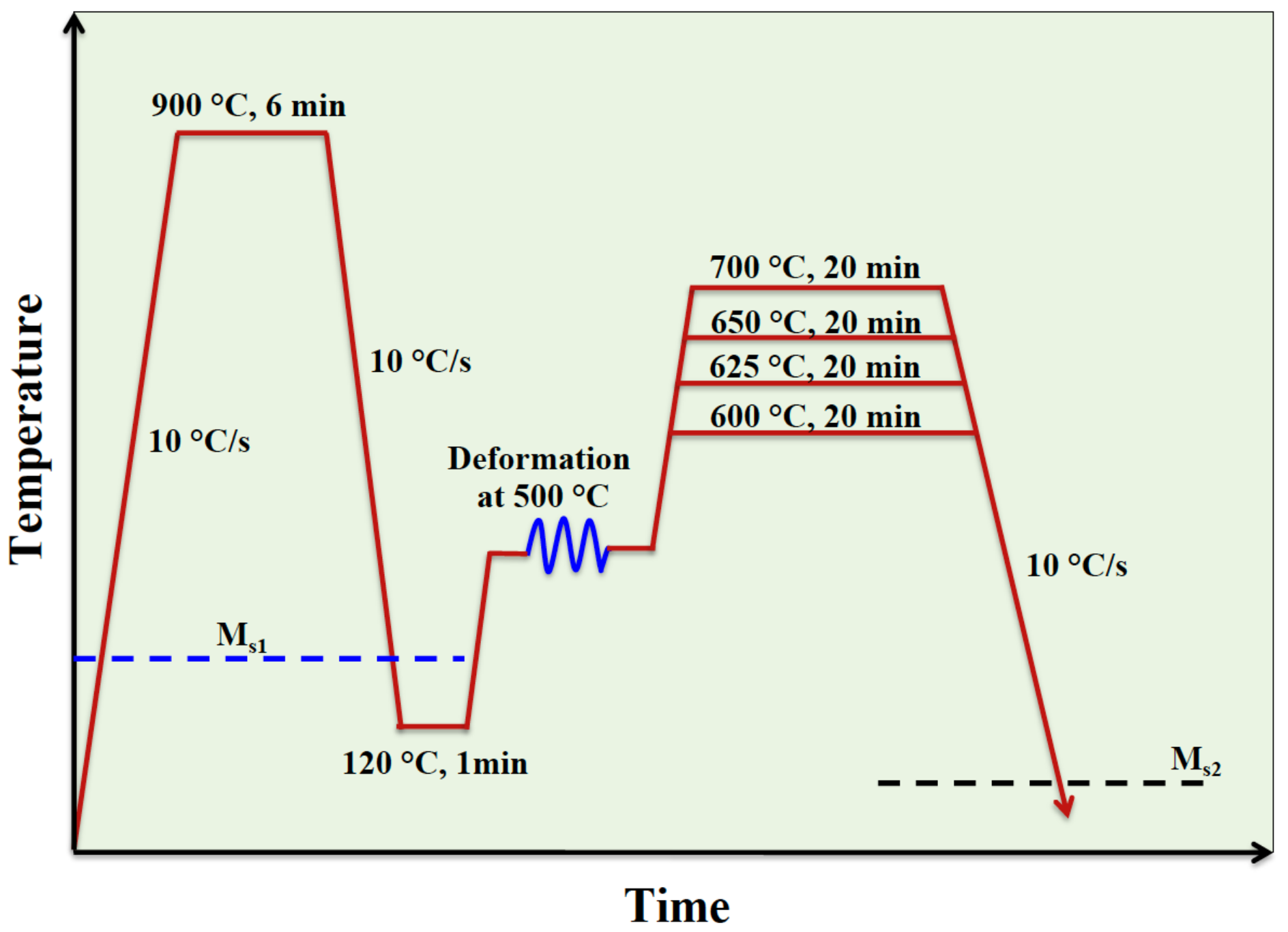
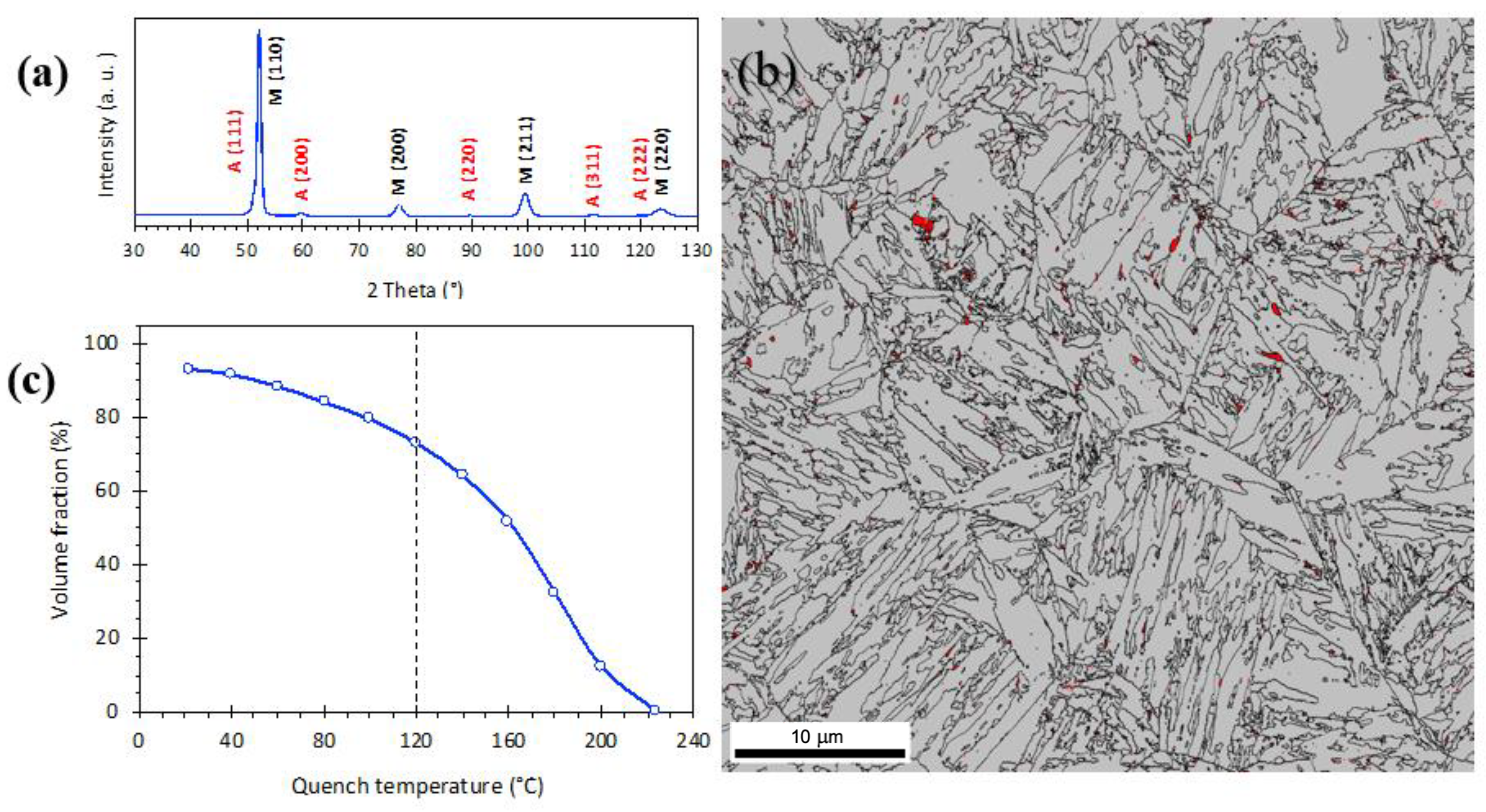
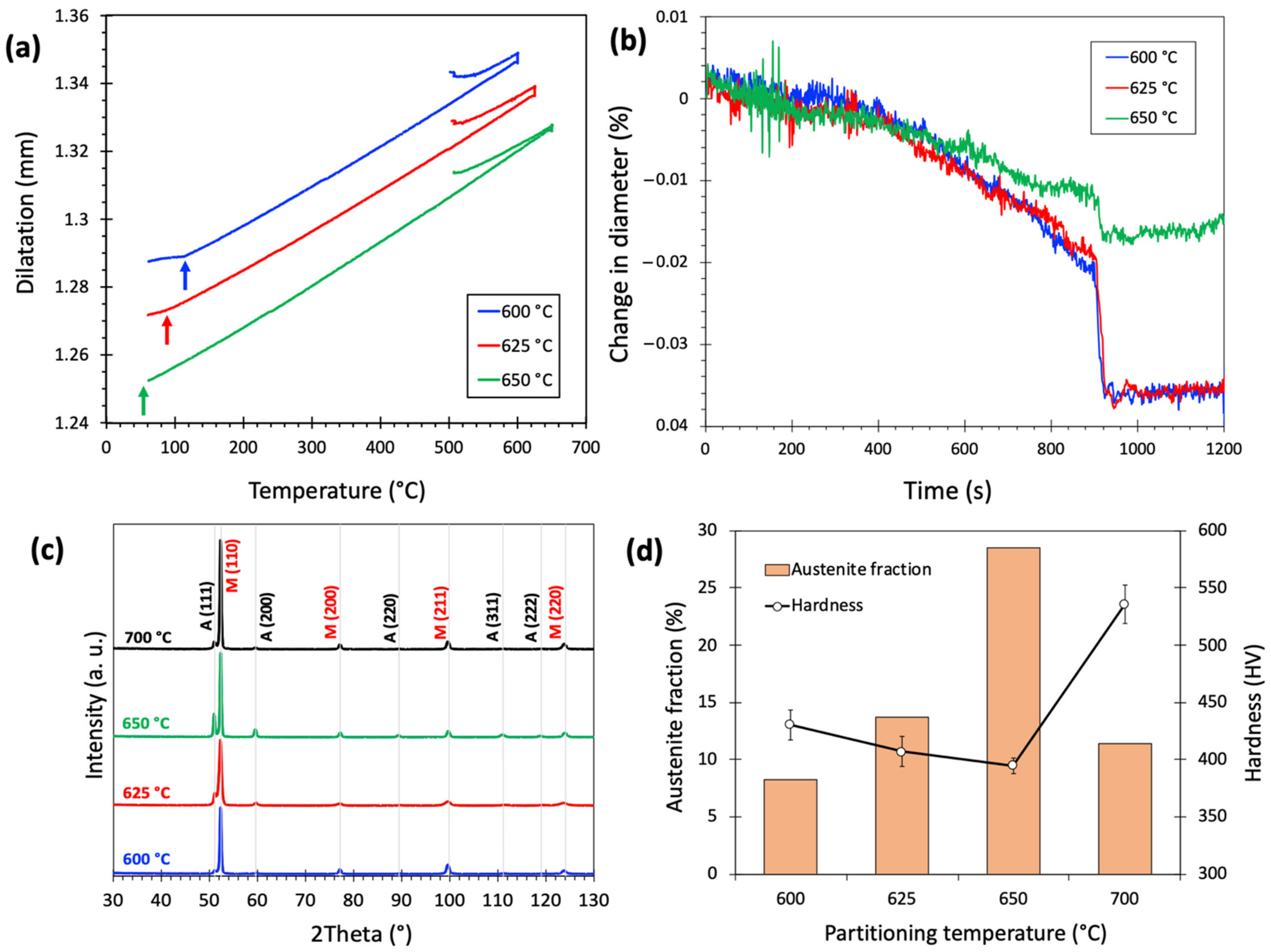


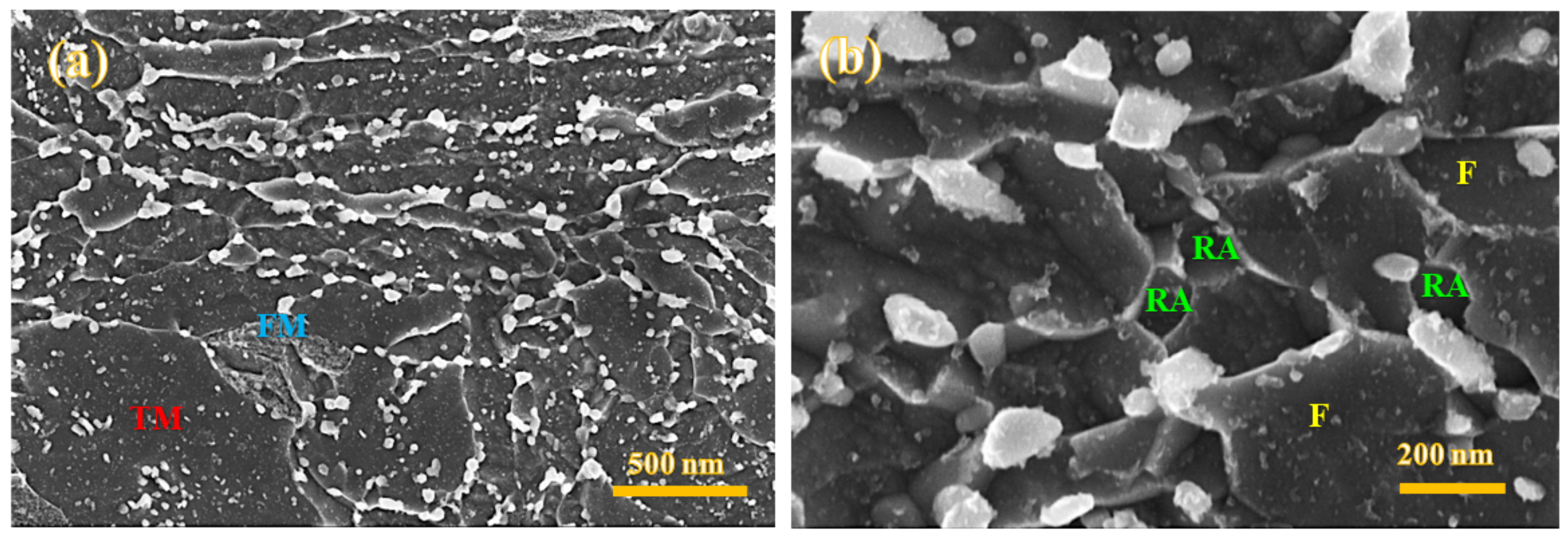

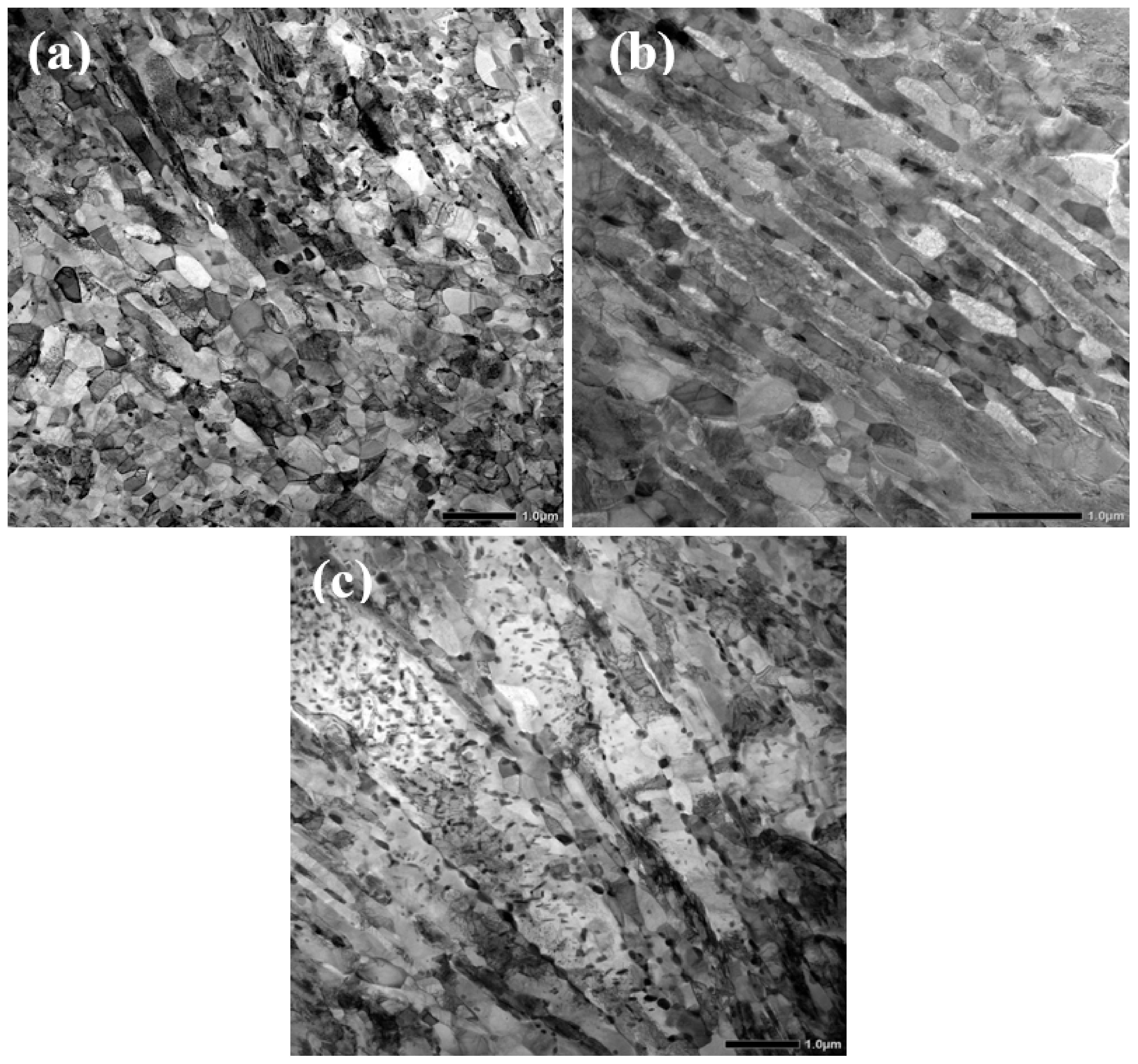
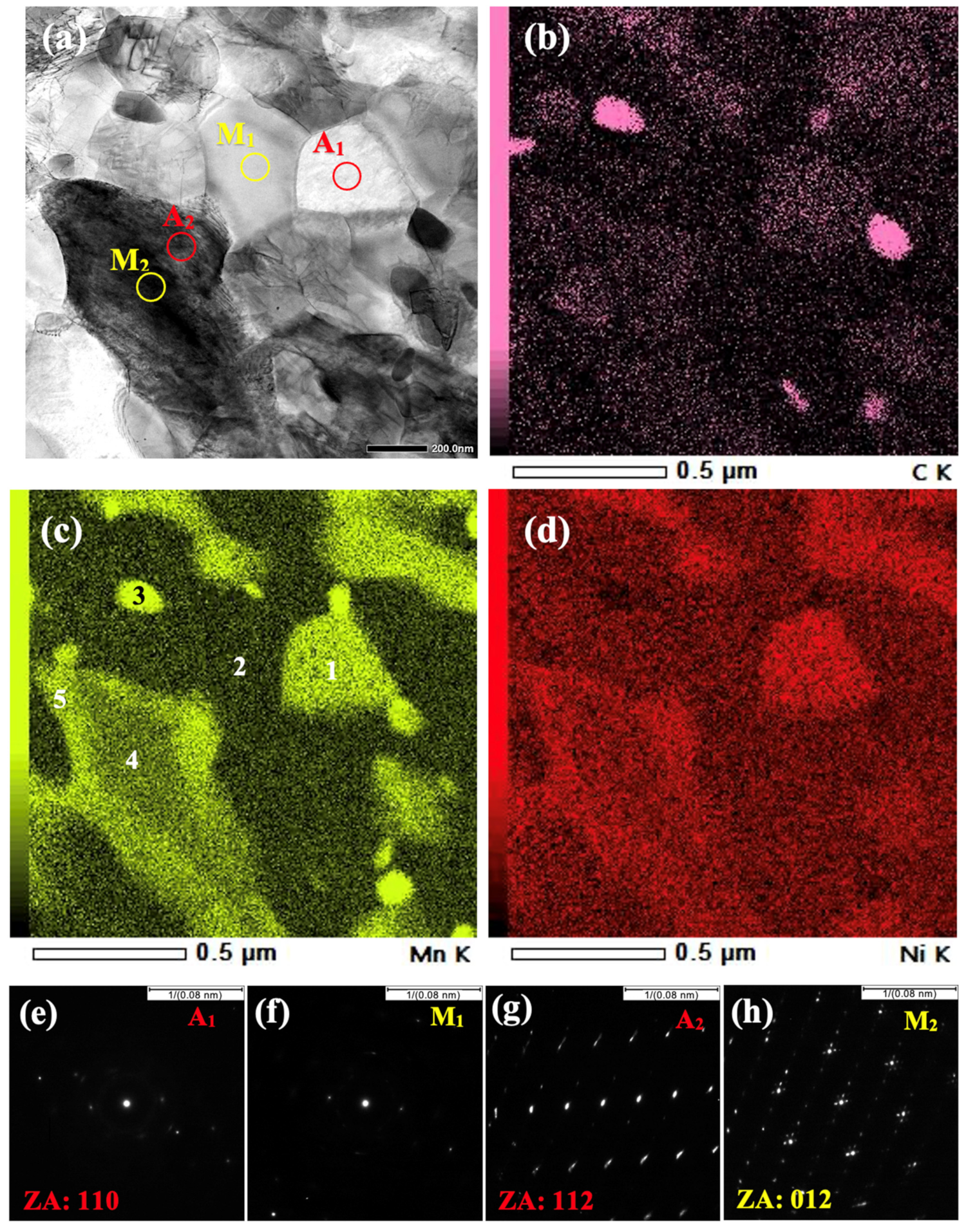
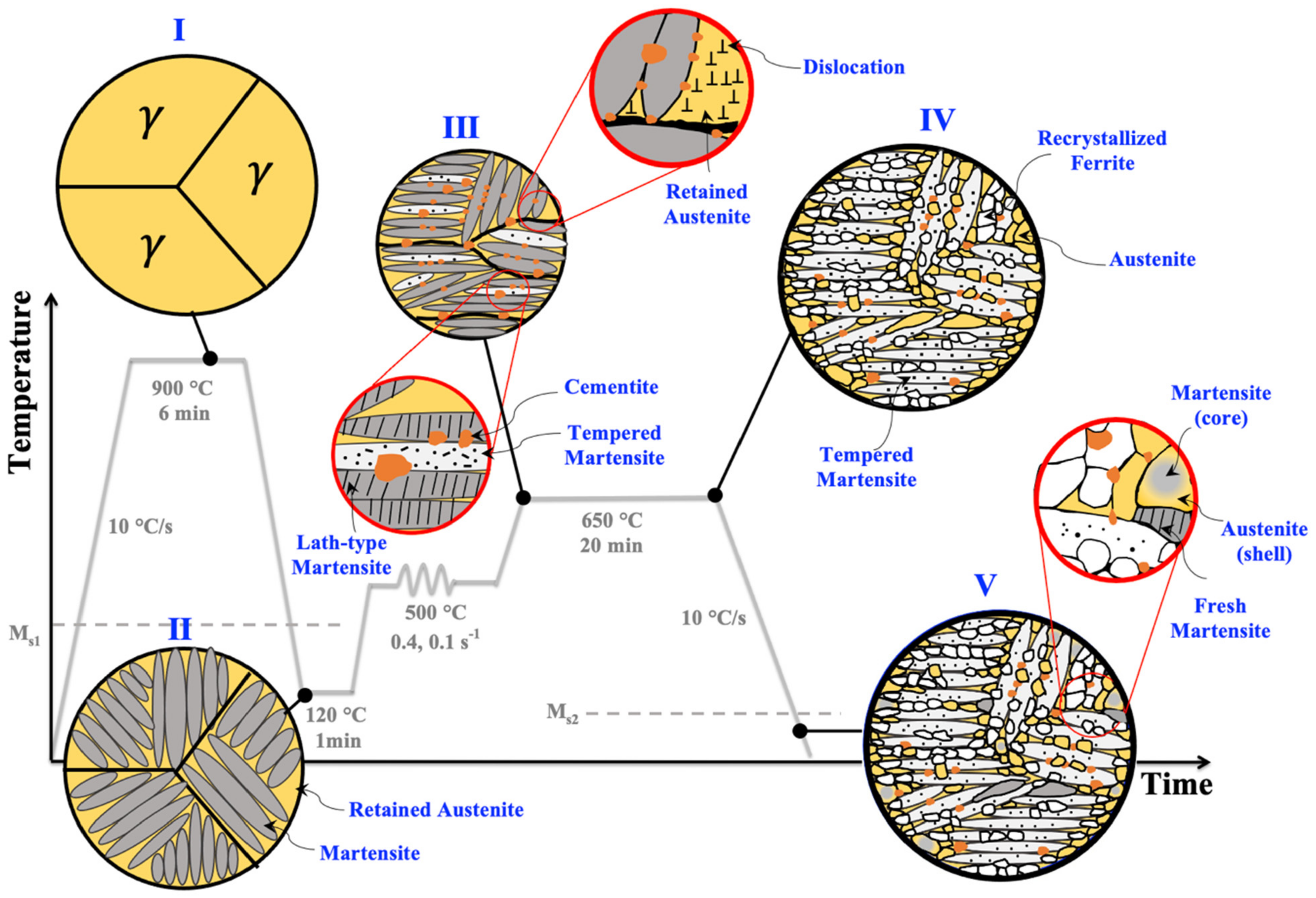
| Position | Mn | C | Ni | Al | Si | Mo | Phase |
|---|---|---|---|---|---|---|---|
| 1 | 6.71 | 1.27 | 2.06 | 0.34 | 0.20 | 2.62 | RA |
| 2 | 2.84 | - | 0.99 | 0.32 | 0.46 | 0.63 | F |
| 3 | 15.73 | 9.41 | 0.95 | 0.07 | 0.19 | 0.54 | Carbide |
| 4 | 4.66 | 0.88 | 1.98 | 0.24 | 0.59 | 1.58 | FM |
| 5 | 7.08 | 1.73 | 2.40 | 0.05 | 0.49 | - | RA |
| Sample | Recrystallized Ferrite Fraction (%) | Recrystallized Austenite Fraction (%) | RA Average and Range of Grain Size (μm) | Ferrite Average and Range of Grain Size (μm) | RA Fraction (%) | Ms (°C) | RA SFE (mJ/m2) |
|---|---|---|---|---|---|---|---|
| def-500 | 26 | 73 | 0.23 (0.07–0.99) | 0.31 (0.11–5.51) | 29 | −70 | 45 |
| def-250 | 56 | 78 | 0.24 (0.07–1.32) | 0.24 (0.09–2.97) | 32 | −89 | 48 |
| non-def | 0 | 0 | 0.2–0.3 * | 0.8–2 * | 34 | −105 | 48 |
Publisher’s Note: MDPI stays neutral with regard to jurisdictional claims in published maps and institutional affiliations. |
© 2022 by the authors. Licensee MDPI, Basel, Switzerland. This article is an open access article distributed under the terms and conditions of the Creative Commons Attribution (CC BY) license (https://creativecommons.org/licenses/by/4.0/).
Share and Cite
Sadeghpour, S.; Javaheri, V.; Somani, M.; Kömi, J.; Karjalainen, P. Heterogeneous Multiphase Microstructure Formation through Partial Recrystallization of a Warm-Deformed Medium Mn Steel during High-Temperature Partitioning. Materials 2022, 15, 7322. https://doi.org/10.3390/ma15207322
Sadeghpour S, Javaheri V, Somani M, Kömi J, Karjalainen P. Heterogeneous Multiphase Microstructure Formation through Partial Recrystallization of a Warm-Deformed Medium Mn Steel during High-Temperature Partitioning. Materials. 2022; 15(20):7322. https://doi.org/10.3390/ma15207322
Chicago/Turabian StyleSadeghpour, Saeed, Vahid Javaheri, Mahesh Somani, Jukka Kömi, and Pentti Karjalainen. 2022. "Heterogeneous Multiphase Microstructure Formation through Partial Recrystallization of a Warm-Deformed Medium Mn Steel during High-Temperature Partitioning" Materials 15, no. 20: 7322. https://doi.org/10.3390/ma15207322







